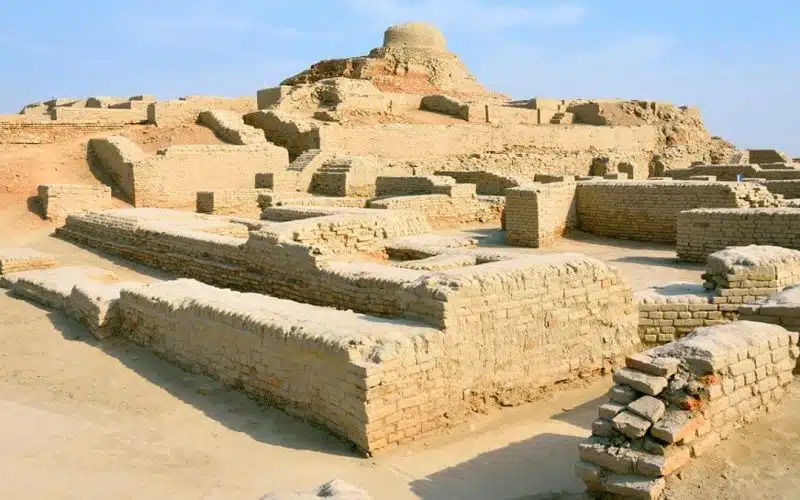Embark on a historical odyssey as we delve into the cradle of one of the world’s earliest civilizations—the Indus River Valley. The Indus River Valley Civilization, also known as the Harappan Civilization, was a Bronze Age society from 3300 BCE to 1300 BCE, extending from Afghanistan to Pakistan and northwest India. It developed standardized weights, seal carving, and metallurgy, and developed the Indus Script or Harappan Script. There is a lot of information embedded in this article detailing the story of the Indus River Valley Civilization as you read further.
Indus River Valley Civilization
The Indus River Valley Civilization, also known as the Harappan Civilization, was a Bronze Age society that existed from approximately 3300 BCE to 1300 BCE. It extended from modern-day northeast Afghanistan to Pakistan and northwest India.
Characteristics of the Indus River Valley Civilization
#1. Geography and Time-frame
The civilization was located in the valley of the Indus River, which flows through modern-day Pakistan. It covered an area as large as Western Europe. The civilization developed in three phases: Early Harappan Phase (3300 BCE-2600 BCE), Mature Harappan Phase (2600 BCE-1900 BCE), and Late Harappan Phase (1900 BCE-1300
#2. Innovations
The Indus River Valley Civilization made several important innovations. These include standardized weights and measures, seal carving, and metallurgy with copper, bronze, lead, and tin. The inhabitants developed new techniques in handicraft, such as Carnelian products, and were skilled in metallurgy.
#3. Writing System
The civilization is believed to have developed a writing system known as the Indus Script or Harappan Script. However, this script has not yet been deciphered, so little is known about the civilization’s institutions and systems of governance.
#4. Cities
The two major cities of the Indus River Valley Civilization were Harappa and Mohenjo-daro. These cities emerged around 2600 BCE along the Indus River Valley in present-day Pakistan. Excavations at these sites have provided important archaeological data about the civilization’s technology, art, trade, transportation, writing, and religion.
#5. Trade and Economy
The civilization had a thriving trade network, both within the region and with other civilizations. Archaeological evidence suggests that the Indus River Valley Civilization engaged in long-distance trade with regions as far as Central Asia, Mesopotamia, and the Persian Gulf. They traded a variety of goods, including textiles, pottery, precious stones, and metals.
#6. Art and Craftsmanship
The Indus River Valley Civilization had a rich artistic tradition. They created sculptures, seals, pottery, and jewelry using materials such as terracotta, metal, and stone. The craftsmanship of their artifacts reflects their skill and artistic sensibilities.
#7. Urban Infrastructure and Architecture
The civilization had well-developed urban centers. Cities such as Harappa, Mohenjo-daro, and others had advanced urban planning and infrastructure. They featured sophisticated drainage systems, public baths, brick platforms, granaries, and warehouses. The architecture of these cities reflects a high level of planning and engineering skills.
The presence of craft specialization, localized craft groupings, and variations in house types and sizes at sites like Mohenjo-daro suggest some degree of social stratification within the civilization. This indicates the existence of social hierarchies and possibly a ruling elite.
#9. Technological Advancements
The people of the Indus River Valley Civilization achieved notable technological advancements. They developed a system of uniform weights and measures, which is evident from the precision in their measuring systems and the uniform size of bricks used in construction. They also had advanced techniques in seal carving and metallurgy, working with materials like copper, bronze, lead, and tin.
#10. Decline and Disappearance
The decline of the Indus River Valley Civilization is still a subject of debate among scholars. One theory suggests that climate change and migration played a role in its demise. The changing course of the river, combined with environmental factors, may have led to the abandonment of cities and the shift to smaller settlements in the Himalayan foothills.
Where Was The Indus River Valley Civilization
The Indus River Valley Civilization existed from approximately 3300 BCE to 1300 BCE in the region that extends from modern-day northeast Afghanistan to Pakistan and northwest India. The civilization developed in the river valleys of the Indus and Ghaggar-Hakra, and its major cities were located in present-day Pakistan.
Environmental Factors That Influenced The Indus River Valley Civilization
#1. Availability of Water
The civilization developed along the Indus River and its tributaries, which provided a reliable water source for agriculture. The river’s annual flooding brought fertile silt, allowing for productive farming.
#2. Fertile Soil
The floodplains of the Indus River provided rich alluvial soil, which supported agricultural activities. The fertile soil enabled the cultivation of crops such as wheat, barley, peas, and cotton.
#3. Geographical Protection
The natural geography of the region, including the surrounding mountains and deserts, provided a level of protection against external invasions. This allowed the civilization to develop and flourish without constant threats from neighboring regions.
#4. Climate
The climate of the Indus River Valley, characterized by hot summers and mild winters, was conducive to agricultural productivity. The availability of water and favorable climate conditions supported the growth of crops and sustained civilization.
#5. Trade Routes
The Indus River Valley Civilization was strategically located along trade routes connecting different regions, including Mesopotamia and Central Asia. This facilitated trade and cultural exchange, contributing to the economic and cultural development of the civilization.
#6. Hydraulic Economy
The civilization’s strong government control over the limited resources of river water characterized their institutions. The availability and control of water played a central role in economic processes and allowed for the establishment of a monopoly.
#7. Migration
Climate change and shifts in weather patterns over time have impacted civilization. Changes in monsoon patterns and the drying up of summer rains made agriculture difficult near Harappan cities, leading to migration and the establishment of smaller communities in the foothills.
#8. Protection from Flooding
The civilization developed along the Indus River, which posed a risk of flooding. To mitigate this risk, the people constructed levees to prevent the river from flooding their cities during storm surges.
Indus River Valley Civilization Religion
The religion of the Indus River Valley Civilization, also known as the Harappan Civilization, remains a subject of speculation and debate due to the limited evidence available and the undeciphered nature of the Indus script.
Available Details Of Indus River Valley Civilization Religion
#1. Lack of Temples
The absence of obvious temples or religious structures in the archaeological remains of the civilization has puzzled scholars. There are no buildings that are universally agreed upon to have had a religious function.
#2. Speculative Conclusions
Due to the scarcity of evidence, conclusions about the religion of the Indus River Valley Civilization are partly speculative. Many interpretations are based on a retrospective view from a later Hindu perspective.
#3. Cult of the Dead
The presence of grave goods, such as pottery and jewelry, in burials, indicates the belief in an afterlife or the practice of honoring the deceased. These practices may have involved rituals and offerings to ensure the well-being of the deceased in the afterlife.
#4. Seal Iconography
The civilization’s seals depict various motifs, including animals, humans, and possibly deities. Some scholars have suggested that these seals may have had religious or ritualistic significance. However, the exact meanings and interpretations of these symbols are still uncertain.
#5. Possible Ritual Practices
The presence of public baths and the uniformity of certain artifacts, such as pottery and weights, have led to speculations about communal or ritualistic practices. The purpose of these practices, whether religious or otherwise, is not fully understood.
#6. Animal Worship
The depiction of animals, especially bulls, on seals and other artifacts suggests a possible connection to animal worship or reverence. The significance of these animal motifs and their role in religious practices is a topic of ongoing research.
#7. Water and Purification
The presence of well-planned drainage systems and public baths in the cities of civilization has led some scholars to speculate about the importance of water and purification rituals in their religious practices. However, the exact nature and significance of these rituals are not known.
#8. Possible Ancestor Worship
Some scholars propose that ancestor worship may have been a part of the religious beliefs of the Indus River Valley Civilization. The presence of burial sites and the careful treatment of the dead suggest a reverence for ancestors or a belief in an afterlife.
What Happened To The Indus River Valley Civilization?
The decline and disappearance of the Indus River Valley Civilization, also known as the Harappan Civilization, is a topic of debate among scholars.
Here’s what might have happened to civilization.
#1. Climate Change and Environmental Factors
One theory suggests that climate change played a significant role in the decline of civilization. The eastward shift of monsoons may have reduced the water supply, leading to agricultural difficulties and the migration of people to more favorable regions. This could have resulted in the abandonment of urban centers and the establishment of smaller villages and isolated farms.
#2. Migration and Population Shifts
Another theory proposes that population shifts and migrations contributed to the decline. The inhabitants of the Indus River Valley civilization may have migrated eastward to the Himalayan foothills of the Ganga-Yamuna basin. This movement could have led to a shift from large cities to smaller farming villages, ultimately resulting in the decline of urban centers.
#3. Aryan Invasion
The Aryan Invasion Theory suggests that a nomadic Indo-European tribe called the Aryans invaded and conquered the Indus River Valley civilization. However, this theory is controversial and not universally accepted by scholars.
Some scholars argue that internal factors, such as social and economic changes, may have contributed to the decline. These factors could include social unrest, economic instability, or changes in trade patterns.
#5. Lack of Adaptability
The civilization may have faced challenges in adapting to changing circumstances, whether it be environmental changes, social dynamics, or economic shifts. If civilization was unable to effectively respond and adapt to these challenges, it could have contributed to its decline.
Internal factors such as social unrest, political instability, and conflicts within the civilization may have played a role in its decline. The absence of clear centralized political structures and the presence of potential social stratification could have led to internal divisions and conflicts.
#7. Trade Disruptions
Disruptions in long-distance trade networks and economic connections with other regions could have harmed the economy of the civilization. Changes in trade patterns, conflicts with neighboring regions, or the collapse of trade routes might have affected the prosperity and stability of civilization.
#8. Epidemics and Disease
Epidemics or widespread diseases, played a role in the decline. The proximity and high population density in urban centers could have facilitated the spread of diseases, leading to a decline in the population and overall societal disruption.
Indus River Valley Civilization Cities
The Indus River Valley Civilization was characterized by several well-planned and organized cities.
Here are some of the notable cities of the civilization:
#1. Harappa
Harappa is one of the most well-known cities of the Indus River Valley Civilization. Located in modern-day Pakistan, it was a major urban center with a population estimated to have been around 40,000–50,000 people. Harappa is known for its impressive urban planning, including well-ordered wastewater drainage systems and a grid-like street layout.
#2. Mohenjo-Daro
Mohenjo-daro, also situated in modern-day Pakistan, was another significant city of the civilization. It is considered one of the largest urban centers of the ancient world, with a population estimated to have been around 40,000–50,000 people. Mohenjo-daro showcases advanced urban planning, including a complex water management system, public baths, and a citadel.
#3. Dholavira
Dholavira is located in modern-day India and is one of the most remarkable cities of the Indus River Valley Civilization. It features an intricate water management system, including reservoirs and channels, which highlights the civilization’s expertise in hydraulic engineering. Dholavira also has a well-structured urban layout with fortified walls and distinct sectors.
#4. Kalibangan
Kalibangan, situated in modern-day India, was an important city of civilization. It is known for its unique fire altars and evidence of early plowed fields, indicating agricultural practices. The city also had a well-defined fortification system and a sophisticated drainage system.
#5. Lothal
Lothal, located in modern-day India, was a significant port city of the Indus River Valley Civilization. It served as a center for maritime trade and featured a dockyard with a complex system of channels and reservoirs. Lothal also had a well-structured urban layout, including residential and industrial areas.
#8. Surkotada
Surkotada, located in modern-day India, was a smaller civilization. It is known for its fortified walls and evidence of craft production, particularly in the form of copper and bronze artifacts. Surkotada also had a well-structured drainage system.
#7. Rakhigarhi
Rakhigarhi, located in modern-day India, is one of the largest and most significant sites of the Indus River Valley Civilization. It is considered the largest known city of the civilization, covering an area of around 350 hectares. Rakhigarhi showcases well-planned streets, residential areas, and a citadel, indicating a highly organized urban center.
#8. Rupar
Rupar, situated in modern-day India, was an important city of civilization. It is known for its archaeological remains, including a well-structured drainage system and evidence of craft production. Rupar also had a fortified citadel, suggesting the presence of a ruling authority.
#9. Ganweriwala
Ganweriwala, located in modern-day Pakistan, was a significant city of the Indus River Valley Civilization. It had a well-organized layout with streets and buildings made of mud bricks. Ganweriwala is known for its extensive cemetery, indicating the importance of burial practices in the civilization.
#10. Manda
Manda, situated in modern-day Pakistan, was a smaller city of civilization. It is known for its unique circular structures, which may have served as religious or ceremonial sites. Manda also had a well-planned layout with streets and residential areas.
What Is the Indus River Valley Civilization Known?
The Indus River Valley Civilization, also known as the Harappan Civilization, is known for its advanced urban planning, standardized weights and measures, seal carving and Indus Script, metallurgy and craftsmanship, trade and commerce, and its eventual decline and migration. The civilization’s well-organized cities, sophisticated infrastructure, and cultural achievements contribute to its significance in ancient history.
Who Founded the Indus Valley Civilization?
There wasn’t a particular person or group responsible for starting the Indus River Valley Civilization. The civilization emerged and developed over time as a result of the migration and settlement of people in the river valleys of the Indus and Ghaggar-Hakra. The inhabitants of the civilization migrated towards the Himalayan foothills of the Ganga-Yamuna basin. The exact origins and processes of the civilization’s formation are still subjects of ongoing research and study.
What Is The History Of The Indus River?
The Indus River has a long history that dates back millions of years. It originated from the tectonic plate collision-induced uplift of Tibet. The river flows through various regions, including the Swat River, Hazara, and the Punjab Plain. It played a crucial role in the development of the ancient Indus River Valley Civilization, also known as the Harappan Civilization. This civilization thrived along the Indus River from around 3300 to 1300 BCE.
What Is The Oldest Civilization On Earth?
The Mesopotamian civilization is often considered the oldest recorded civilization, with the Sumerians being credited as its founders. The Mesopotamian civilization emerged around 4000 BCE in what is now Iraq. However, other contenders for the title of the oldest civilization include the Egyptian civilization, the Indus Valley civilization, and the Aboriginal Australians, who have a history dating back approximately 75,000 years. The exact determination of the oldest civilization depends on various factors and perspectives.
What Language Did Indus Valley Speak?
The Indus Valley Civilization, also known as the Harappan Civilization, is a region with a language that remains unknown due to the undeciphered Indus script. Various hypotheses and analyses have been proposed, including loanwords and substratum influences in Vedic Sanskrit and Sumerian cuneiform, connections to ancient Dravidian languages, and the existence of multiple languages or language groups. The lack of deciphered written documents further complicates the determination of the language spoken during this period.
Conclusion
The Indus River Valley Civilization, spanning from 3300 BCE to 1300 BCE, thrived on water availability, fertile soil, geographical protection, favorable climate, and strategic location along trade routes, enabling the cultivation of crops like wheat, barley, peas, and cotton and contributing to economic and cultural development. Religion remains a subject of speculation due to the absence of temples, speculative conclusions, the cult of the dead, seal iconography, and possible ritual practices that remain unexplored. Theories suggest climate change, migration, the Aryan invasion, social and economic changes, and a lack of adaptability contributed to its decline.
- WHY DID THE GREAT MIGRATION HAPPEN?
- What is the Great Migration? All You Need To Know
- VOLUNTOURISM: Everything You Need To Know
- WHAT IS ECOTOURISM? Types, And Characteristics






